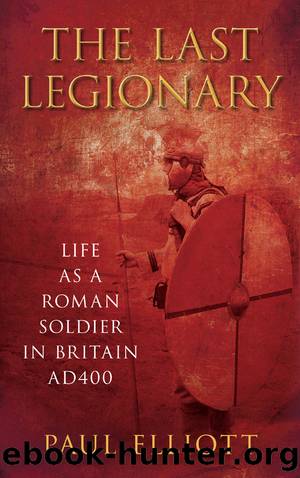The Last Legionary by Paul Elliott

Author:Paul Elliott
Language: eng
Format: epub
ISBN: 9780752474663
Publisher: The History Press
Marching Diaries
What were these marches like? The author has joined members of the research group Comitatus on a number of marches to investigate the properties of Late Roman equipment. These cross-country walks were intended to be highly authentic, but they recreated only elements of the Roman marching experience rather than duplicate a complete Roman patrol from start to finish. Each march has focussed on a different type of mission and a different load of equipment. Three marches in particular provided valuable information â the first, a climb to the summit of Scafell Pike, Englandâs highest mountain, the second, a 12-km march along the highest and most rugged section of Hadrianâs Wall, and third, a march along the line of a Roman road cutting across the North Yorkshire Moors. To gain useful results from the marches, each needed to represent some kind of Late Roman objective, and the planning of the expedition followed naturally from there.
The first march involved a walk from Hardknott Roman fort in Cumbria, up the Esk valley toward the base of Scafell Pike. From there the walkers would climb to the summit. Worries about what to take (and what not to take) plagued us even at the moment of departure. The weather was cold and we needed to be wary of rain, maybe even snow and sleet. It would certainly be extremely cold at the summit with wind chill factored in. The walk would warm us up, however, and of course, no-one wanted to be overburdened. We all wore Late Roman long-sleeved tunics of wool, woollen bracae and socks. We all wore a woollen sagum (rectangular army cloak) and each of us had a period hat to wear. Additionally, we carried ration bags, wool mittens and lots of water. To carry water we used leather waterbags. The extremely rugged terrain meant that this walk would be undertaken as a light troop unit, but we still had to be combat capable. The author took a long sword (spatha), recurve bow and quiver full of arrows. His companions took either short spears or spicula, as well as an axe or spatha. It was important that we have everything at hand for a fight. As a light infantry squad we were tasked with reconnaissance not combat, but every soldier was still required to pull his weight in a fight. No-one took helmets, although one walker did wear a scale armour corselet, and all the spearmen carried small round shields. We had settled on our choice of arms and armour without reference to Vegetius or Maurice, but once the walk was over we were delighted to find that the Strategikon recommended that light troops be sent into mountains in four-man squads, with the very equipment load that we had used. This vindicated both our approach and our choice of weapons.
We did attempt to rationalise our route, and came to two conclusions. At Hardknott Fort, a desolate posting if ever there was one, we could see the rugged nature of the terrain and imagine the plight of the soldiers stationed there.
Download
This site does not store any files on its server. We only index and link to content provided by other sites. Please contact the content providers to delete copyright contents if any and email us, we'll remove relevant links or contents immediately.
The Daily Stoic by Holiday Ryan & Hanselman Stephen(3263)
The Fate of Rome: Climate, Disease, and the End of an Empire (The Princeton History of the Ancient World) by Kyle Harper(3030)
People of the Earth: An Introduction to World Prehistory by Dr. Brian Fagan & Nadia Durrani(2711)
Ancient Worlds by Michael Scott(2648)
Babylon's Ark by Lawrence Anthony(2644)
The Daily Stoic by Ryan Holiday & Stephen Hanselman(2520)
Foreign Devils on the Silk Road: The Search for the Lost Treasures of Central Asia by Peter Hopkirk(2441)
India's Ancient Past by R.S. Sharma(2432)
MOSES THE EGYPTIAN by Jan Assmann(2393)
The Complete Dead Sea Scrolls in English (7th Edition) (Penguin Classics) by Geza Vermes(2254)
Lost Technologies of Ancient Egypt by Christopher Dunn(2206)
The Earth Chronicles Handbook by Zecharia Sitchin(2202)
24 Hours in Ancient Rome by Philip Matyszak(2064)
Alexander the Great by Philip Freeman(2044)
Aztec by Gary Jennings(1990)
The Nine Waves of Creation by Carl Johan Calleman(1897)
Curse Tablets and Binding Spells from the Ancient World by Gager John G.;(1851)
Before Atlantis by Frank Joseph(1828)
Earthmare: The Lost Book of Wars by Cergat(1805)
